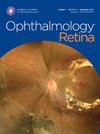Association of Neighborhood Socioeconomic Disadvantage with Proliferative Diabetic Retinopathy
IF 4.4
Q1 OPHTHALMOLOGY
引用次数: 0
Abstract
Purpose
To evaluate the association between neighborhood socioeconomic deprivation, distance from ophthalmology clinics, and diagnosis of proliferative diabetic retinopathy (PDR).
Design
Retrospective cohort study.
Participants
Adult patients (≥18 years) with diabetes mellitus at Johns Hopkins Hospital and University of Wisconsin–Madison.
Methods
Patient addresses were geocoded and the block group was linked to the 2021 national Area Deprivation Index (ADI). Area Deprivation Index was divided into quartiles, with higher quartiles indicating greater socioeconomic disadvantage. The distance between patient’s residence and ophthalmology clinics was calculated. Multivariable logistic regression models were used to analyze the association between ADI quartile, distance from clinic, and PDR, adjusted for demographics and insurance status. The interaction between ADI and distance was tested.
Main Outcome Measures
Diagnosis of PDR.
Results
A total of 73 618 patients were included. A significant interaction was observed between ADI quartile and distance from ophthalmology clinics (P < 0.001). Among patients residing within 8 miles of clinics, those in higher ADI quartiles had increased odds of PDR compared with those in ADI Q1 (Q2: odds ratio [OR], 1.36; 95% confidence interval [CI], 1.12–1.65; Q3: OR, 1.79; 95% CI, 1.46–2.19; Q4: OR, 2.60; 95% CI, 2.09–3.25; P < 0.001 for trend). Conversely, for patients living more than 8 miles from clinics, the odds of PDR were similar across ADI quartiles (Q1: OR, 0.85; 95% CI, 0.73–0.98; Q2: OR, 1.02; 95% CI, 0.87–1.12; Q3: OR, 1.08; 95% CI, 0.90–1.30). However, patients in all ADI quartiles more than 8 miles had greater odds of PDR compared with those in the same ADI quartile within 8 miles (OR, 3.15; 95% CI, 2.61–3.80; OR, 1.97; 95% CI, 1.71–2.27; OR, 1.79; 95% CI, 1.51–2.12; and OR, 1.31; 95% CI, 1.07–1.61 in ADI Q1–Q4, respectively).
Conclusions
Patients living in neighborhoods with greater socioeconomic disadvantage and farther from ophthalmology clinics have greater odds of PDR. These findings suggest the potential utility of targeted interventions in socioeconomically deprived and distant areas to reduce PDR-related blindness.
Financial Disclosure(s)
Proprietary or commercial disclosure may be found in the Footnotes and Disclosures at the end of this article.
邻里社会经济劣势与增生性糖尿病视网膜病变的关系
目标或目的:评估社区社会经济贫困程度、与眼科诊所的距离和增殖性糖尿病视网膜病变(PDR)诊断之间的关联:研究对象、参与者和/或对照组:方法、干预或测试:对患者地址进行地理编码,并将街区组与 2021 年全国地区贫困指数 (ADI) 联系起来。ADI分为四等分,四等分越高表示社会经济条件越差。计算患者住所与眼科诊所之间的距离。使用多变量逻辑回归模型分析 ADI 四分位数、与诊所的距离和 PDR 之间的关系,并对人口统计学和保险状况进行调整。测试了 ADI 与距离之间的交互作用:结果结果:共纳入 73618 名患者。ADI四分位数与眼科诊所距离之间存在明显的交互作用(P < .001)。在距离诊所 8 英里以内的患者中,ADI 四分位数较高的患者发生 PDR 的几率要高于 ADI 四分位数为 1 的患者(Q2:OR 1.36,95% CI 1.12-1.65;Q3:OR 1.79,95% CI 1.46-2.19;Q4:OR2.60,95% CI 2.09-3.25;PC 结论:生活在社会经济条件较差、距离眼科诊所较远的社区的患者发生 PDR 的几率更高。这些研究结果表明,在社会经济条件较差和距离较远的地区采取有针对性的干预措施,可能会减少与 PDR 相关的失明。
本文章由计算机程序翻译,如有差异,请以英文原文为准。
求助全文
约1分钟内获得全文
求助全文

 求助内容:
求助内容: 应助结果提醒方式:
应助结果提醒方式:


